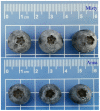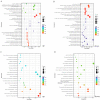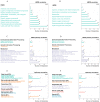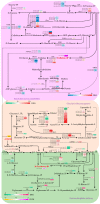Transcriptomic and Metabolomic Profiling Reveals the Variations in Carbohydrate Metabolism between Two Blueberry Cultivars
- PMID: 38203463
- PMCID: PMC10778917
- DOI: 10.3390/ijms25010293
Transcriptomic and Metabolomic Profiling Reveals the Variations in Carbohydrate Metabolism between Two Blueberry Cultivars
Abstract
Blueberry is a high-quality fruit tree with significant nutritional and economic value, but the intricate mechanism of sugar accumulation in its fruit remains unclear. In this study, the ripe fruits of blueberry cultivars 'Anna' and 'Misty' were utilized as experimental materials, and physiological and multi-omics methodologies were applied to analyze the regulatory mechanisms of the difference in sugar content between them. The results demonstrated that the 'Anna' fruit was smaller and had less hardness than the 'Misty' fruit, as well as higher sugar content, antioxidant capability, and lower active substance content. A total of 7067 differentially expressed genes (DEGs) (3674 up-regulated and 3393 down-regulated) and 140 differentially abundant metabolites (DAMs) (82 up-regulated and 58 down-regulated) were identified between the fruits of the two cultivars. According to KEGG analysis, DEGs were primarily abundant in phenylpropanoid synthesis and hormone signal transduction pathways, whereas DAMs were primarily enriched in ascorbate and aldarate metabolism, phenylpropanoid biosynthesis, and the pentose phosphate pathway. A combined multi-omics study showed that 116 DEGs and 3 DAMs in starch and sucrose metabolism (48 DEGs and 1 DAM), glycolysis and gluconeogenesis (54 DEGs and 1 DAM), and the pentose phosphate pathway (14 DEGs and 1 DAM) were significantly enriched. These findings suggest that blueberries predominantly increase sugar accumulation by activating carbon metabolism network pathways. Moreover, we identified critical transcription factors linked to the sugar response. This study presents new understandings regarding the molecular mechanisms underlying blueberry sugar accumulation and will be helpful in improving blueberry fruit quality through breeding.
Keywords: blueberry; fruit quality; glycolysis/gluconeogenesis; pentose phosphate pathway; starch and sucrose metabolism; sugar accumulation.
Conflict of interest statement
The authors declare no conflicts of interest.
Figures








References
-
- Forney C.F., Qiu S., Jordan M.A., McCarthy D., Fillmore S. Comparison of volatile compounds contributing to flavor of wild lowbush (Vaccinium augustifolium) and cultivated highbush (Vaccinium corymbosum) blueberry fruit using gas chromatography-olfactometry. Foods. 2022;11:2516. doi: 10.3390/foods11162516. - DOI - PMC - PubMed
-
- Su M.-S., Silva J.L. Antioxidant activity, anthocyanins, and phenolics of rabbiteye blueberry (Vaccinium ashei) by-products as affected by fermentation. Food Chem. 2006;97:447–451. doi: 10.1016/j.foodchem.2005.05.023. - DOI
-
- Montecchiarini M.L., Silva-Sanzana C., Valderramo L., Alemano S., Gollán A., Rivadeneira M.F., Bello F., Vázquez D., Blanco-Herrera F., Podestá F.E., et al. Biochemical differences in the skin of two blueberries (Vaccinium corymbosum) varieties with contrasting firmness: Implication of ions, metabolites and cell wall related proteins in two developmental stages. Plant Physiol. Bioch. 2021;162:483–495. doi: 10.1016/j.plaphy.2021.03.016. - DOI - PubMed
MeSH terms
Substances
Grants and funding
LinkOut - more resources
Full Text Sources

